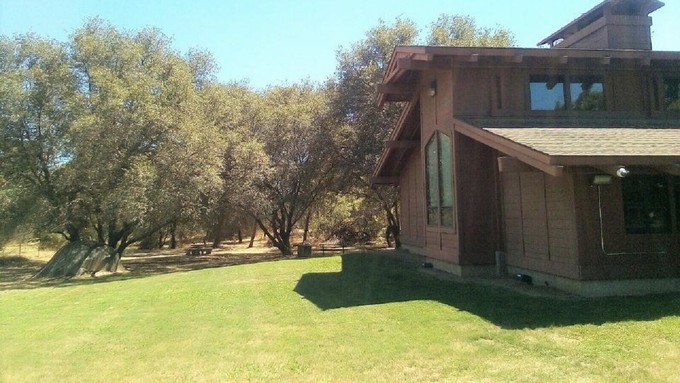
Placer County master gardeners to break ground on 11,000-square-foot project

This area behind the Loomis Library will become the demonstration garden for the Placer County master gardeners. Photo courtesy Loomis Library
A huge asset for Placer County gardeners – plus those from neighboring counties – is one step closer to reality.
On Tuesday morning, Sept. 19, the UC Cooperative Extension Master Gardeners of Placer County will break ground on their own demonstration garden behind Loomis Library. The public is welcome to the 9:30 a.m. ceremony to learn more about the project.
More than a year in the making, the new garden will replace more than 11,000 square feet of lawn with water-wise landscaping plus a demonstration orchard and edible garden.
“In collaboration with the Town of Loomis and the Loomis Library and Community Center, the Master Gardeners will be transforming an existing lawn into a beautiful water-wise garden showcasing California natives, pollinators, and edible plants,” say the master gardeners. “Opportunities for education in the garden will bring a living classroom to the community.”
It takes a community to create such a large new garden, which is being funded mostly via individual donations. The Placer County Water Agency is contributing about $10,000 in rebates and incentives for turf removal and irrigation upgrades. Wood chips and compost for the new garden will be provided by the Town of Loomis.
The Friends of the Loomis Library also are raising money for the garden through their “Buy a Brick” campaign; the engraved bricks will be used in a permanent garden display. You can support the garden by purchasing an engraved brick at https://www.polarengraving.com/floomisl. The bricks cost $120 ($130 with logo).
Or make a contribution directly to the master gardeners at www.pcmg.ucanr.edu.
As its name implies, the new demonstration garden will show how to grow a water-wise and wildlife-friendly garden that looks good year-round while attracting pollinators such as butterflies and bees as well as supporting birds. The garden also will provide space to grow vegetables, fruit, berries and herbs as part of educational displays.
Besides offering a living showcase of the master gardeners’ work, the project will save a significant amount of water by the replacement of all that old lawn. The garden’s design includes places to hold gardening workshops and other events. Signage will identify all the plants and offer tips for home gardeners.
According to library officials, the master gardeners hope to have the first phases of construction including the lawn removal completed in time for fall planting of California natives.
Loomis Library is located at 6050 Library Drive, Loomis.
Comments
0 comments have been posted.Sacramento Digs Gardening to your inbox.
Sites We Like
Garden Checklist for week of April 21
This week there’s plenty to keep gardeners busy. With no rain in the immediate forecast, remember to irrigate any new transplants.
* Weed, weed, weed! Get them before they flower and go to seed.
* April is the last chance to plant citrus trees such as dwarf orange, lemon and kumquat. These trees also look good in landscaping and provide fresh fruit in winter.
* Smell orange blossoms? Feed citrus trees with a low dose of balanced fertilizer (such as 10-10-10) during bloom to help set fruit. Keep an eye out for ants.
* Apply slow-release fertilizer to the lawn.
* Thoroughly clean debris from the bottom of outdoor ponds or fountains.
* Spring brings a flush of rapid growth, and that means your garden is really hungry. Feed shrubs and trees with a slow-release fertilizer. Or mulch with a 1-inch layer of compost.
* Azaleas and camellias looking a little yellow? If leaves are turning yellow between the veins, give them a boost with chelated iron.
* Trim dead flowers but not leaves from spring-flowering bulbs such as daffodils and tulips. Those leaves gather energy to create next year's flowers. Also, give the bulbs a fertilizer boost after bloom.
* Pinch chrysanthemums back to 12 inches for fall flowers. Cut old stems to the ground.
* Mulch around plants to conserve moisture and control weeds.
* From seed, plant beans, beets, cantaloupes, carrots, corn, cucumbers, melons, radishes and squash.
* Plant onion sets.
* In the flower garden, plant seeds for asters, cosmos, celosia, marigolds, salvia, sunflowers and zinnias.
* Transplant petunias, zinnias, geraniums and other summer bloomers.
* Plant perennials and dahlia tubers for summer bloom.
* Mid to late April is about the last chance to plant summer bulbs, such as gladiolus and tuberous begonias.
* Transplant lettuce seedlings. Choose varieties that mature quickly such as loose leaf.